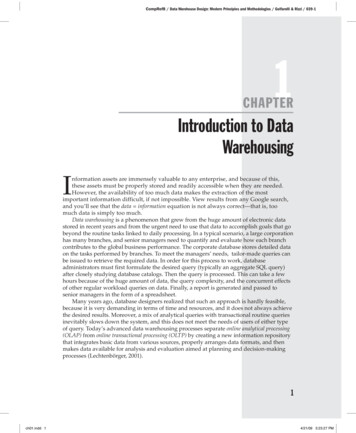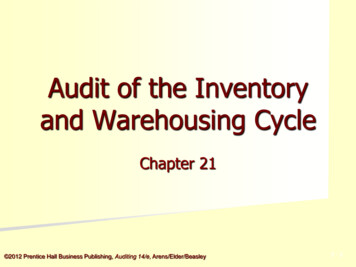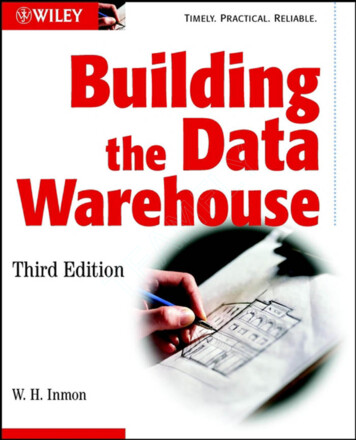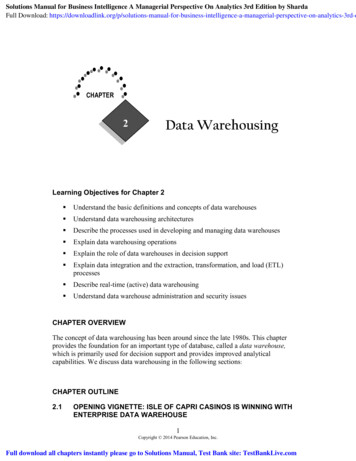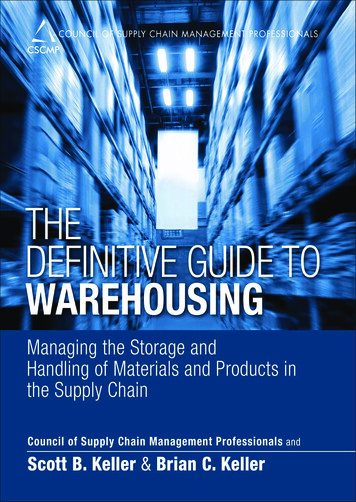
Transcription
THE DEFINITIVE GUIDE TOWAREHOUSING
This page intentionally left blank
THE DEFINITIVE GUIDE TOWAREHOUSINGMANAGING THE STORAGE ANDHANDLING OF MATERIALS ANDPRODUCTS IN THE SUPPLY CHAINCouncil of Supply Chain Management ProfessionalsScott B. Keller and Brian C. Keller
Vice President, Publisher: Tim MooreAssociate Publisher and Director of Marketing: Amy NeidlingerExecutive Editor: Jeanne Glasser LevineConsulting Editor: Chad AutryOperations Specialist: Jodi KemperCover Designer: Chuti PrasertsithManaging Editor: Kristy HartProject Editor: Deadline Driven PublishingCopy Editor: Apostrophe Editing ServicesProofreader: Apostrophe Editing ServicesIndexer: Angie MartinCompositor: Bronkella PublishingManufacturing Buyer: Dan Uhrig 2014 by Council of Supply Chain Management ProfessionalsPublished by Pearson EducationUpper Saddle River, New Jersey 07458For information about buying this title in bulk quantities, or for special sales opportunities (which mayinclude electronic versions; custom cover designs; and content particular to your business, training goals,marketing focus, or branding interests), please contact our corporate sales department at corpsales@pearsoned.com or (800) 382-3419.For government sales inquiries, please contact governmentsales@pearsoned.com.For questions about sales outside the U.S., please contact international@pearsoned.com.Company and product names mentioned herein are the trademarks or registered trademarks of theirrespective owners.All rights reserved. No part of this book may be reproduced, in any form or by any means, without permission in writing from the publisher.Printed in the United States of AmericaFirst Printing December 2013ISBN-10: 0-13-344890-8ISBN-13: 978-0-13-344890-0Pearson Education LTD.Pearson Education Australia PTY, Limited.Pearson Education Singapore, Pte. Ltd.Pearson Education Asia, Ltd.Pearson Education Canada, Ltd.Pearson Educación de Mexico, S.A. de C.V.Pearson Education—JapanPearson Education Malaysia, Pte. Ltd.Library of Congress Control Number: 2013952808
Dedicated to Karen C. Keller—Mother, friend, and familylogistician.
This page intentionally left blank
CONTENTS1 Warehousing’s Role in the Supply Chain. 12 Distribution Center Concept . 153General Warehousing and Distribution Center Strategies . 214 Design and Layout . 455 Personnel. 576 Warehouse Negotiations, Agreements, and Contracts . 797 Warehouse Management . 878Warehouse Performance. 999 The Role of Industrial Product Packaging . 11110 Warehousing and Transportation Interface . 12111 The Importance of Managing Inventory . 14512Selecting Warehouse Locations . 16113Safety and Security. 17314 Equipment and Information Technology . 19515Unique Functioning and Unique Materials Warehousing . 221Glossary of Key Terms and Definitions . 231Index. 257Contentsvii
This page intentionally left blank
ACKNOWLEDGMENTSWe are grateful to Kathryn Cordeiro for her graphic and research support.Acknowledgmentsix
ABOUT THE AUTHORSScott B. Keller is a professor of logistics and marketing at the University of West Florida.He received his Ph.D. from the University of Arkansas and has been on faculty at PennState and Michigan State. His research interests include issues in personnel developmentand performance, and the development of market-oriented cultures within logistics operations. He has conducted research for numerous corporations, and his work has appearedin leading logistics journals. He is the co-editor of the International Journal of LogisticsManagement, an associate editor of the Journal of Business Logistics and a member of theCouncil of Supply Chain Management Professionals. His managerial experience is inwarehousing, motor carrier operations, and ocean freight terminal operations.Brian Keller became an independent consultant in 2006. In this capacity, he has supported commercial industry companies as well as Government entities including theOffice of the Deputy Under Secretary of Defense for Innovation & Technology Transition, the Defense Advanced Research Projects Agency (DARPA), and the Defense Science Board. Previously, Keller was chairman and president of GMA Cover Corporation,a multinational company that designed, manufactured, and supported signature management products including the Ultra Lightweight Camouflage Net System (ULCANS).During Keller’s tenure, GMA won the Department of the Army competitive procurementfor a 1.7B ULCANS production contract. Prior to GMA, Keller was a vice presidentfor Stewart & Stevenson (now part of BAE) where he was responsible for the Family ofMedium Tactical Vehicle (FMTV) A1R program including the successful award of the 4B rebuy production contract. Keller completed a 21-year military career as a logistician, Lieutenant Colonel, and the Army Product Manager for Field Support Systems.He is an alumni of the Harvard Business School, received a Bachelor of Science degreefrom the United States Military Academy at West Point, an MBA degree from the FloridaInstitute of Technology, and an MS degree in industrial engineering from the Universityof Alabama.xAbout the Authors
1WAREHOUSING’S ROLE INTHE SUPPLY CHAINIntroductionThis chapter explores warehousing’s expanded role in customer operations and supplychain management. You learn about historical and current examples of warehouse support to manufacturing, purchasing, and various economies of operations. This chapterdiscusses competitive supply chain strategies, providing examples of value-added servicesthat warehouses can now provide. With the expansion from a one-dimensional storagerepository to a main element of customer supply chains, the warehouse is now expectedto contribute to the overall client business objectives and contribute to cost reductions.Warehousing’s Role in the Supply ChainWarehousing played a role in the storage and exchange of goods for centuries. Long-termstorage to provide product for future consumption has been a utility of warehousingboth past and present. Transit sheds, warehouses connected to a wharf, have facilitatedthe movement and storage of goods embarking or disembarking merchant and militaryvessels supplying domestic and world trade. Rail transportation set in motion the industrial era with the transport of agriculture commodities and livestock; warehousing wasleveraged to store such cargo prior to processing and then distribute finished productstraveling to other parts of North America.Long-term storage and places to interchange products may have been enough utilityprior to and during the initial stage of industrial development; however, U.S. involvement in World War II required the manufacturing of products to support military efforts.Increased manufacturing demanded more storage and organization of raw materials andparts, as well as more room for the stockpiling and strategic positioning of completedmilitary products from ammunition and vehicles, to food stores. Figure 1-1 depicts a1
high-cube military storage warehouse. Warehousing became more of a strategic functionin the chain of supplying the U.S. military and its allies.Figure 1-1 High-cube military storage warehouseArmy Warehouses in World War IIDuring World War II the U.S. Army established supply warehouses in the state of Washington. These depots played critical roles in supplying the war effort in the Pacific.The depots warehoused large quantities of material. The warehouses in Washingtondelivered goods through the ports to support the war in the Aleutian Islands. They alsosupported the war in the Pacific by shipping critical equipment and supplies to Hawaiiand beyond.Engineering breakthroughs partially resulting from war efforts were adopted by industrypost WW II. Although railroads provided dominance in freight transport prior to theWorld War II, motor carriers and eventually air carriers would surface as viable competition for freight transportation. Competitive changes, such as these, changed the faceof warehousing. Now, a warehouse could receive a single truckload of product ratherthan a railcar load of product. Dynamics of unloading a tractor-trailer load compared2THE DEFINITIVE GUIDE TO WAREHOUSING
to unloading a railcar are dramatically different and require differential planning forunloading and storage.At the same time, developments were achieved in forklift handling equipment. Simplepallet jack capabilities were exceeded by higher reach forklifts enabling operators to buildand manage freight in higher vertical storage buildings and reduce the fixed cost of engineering and fabricating the facility.With the proliferation of computers, information exchange in the late 20th centurybecame a game-changer in the way warehouses collected, transmitted, and utilized dataand information within facilities and with warehouse customers. Perhaps computerscame about in such good time to enable warehouse operators better control over theincreasing variety of products demanded by consumers. Ever since the end of WW II,the United States realized a growing middle class society demanding a greater selectionof products that required greater warehouse control. Product variations require greaterskill in inventory control over that of managing a single commodity or a few finishedgoods items. Each unique product type requires a location in the warehouse that it cannot share with a different product type. Moreover, as market expansion spread, so toodid the number of warehouses called upon to service the distant markets. Products tosatisfy customer regions were dedicated to a specific market warehouse. Consequently,the aggregate inventory total for all market warehouses increased the investment in stockrequired to compete for market share.Traditional Roles of WarehousingAlthough supply chains demand greater service value from warehouse operations, thebasic economies of manufacturing, purchasing, and transportation must continue to besupported. Cost trade-offs, along with service expectations, must be evaluated to determine the role of the warehouse in supporting the traditional economies of scale.Supporting Functional Economies of ScaleWide scope business strategies catering to broad-based clientele require large scale purchasing, production, and distribution. Achieving competitive scale demands operatingefficiencies and economies supported by large scale warehousing of supplies and product.Economies of scale in purchasing, production, and transportation have long requiredwarehouse support, and today, need continues for such warehouse support.Role in Supporting Economies of ManufacturingLong manufacturing runs of single products create efficiencies in production processes,allocation of personnel, and capacity utilization of machinery and equipment. A manufacturer and marketer of a major brand of candy found that it would be financially feasible toChapter 1 Warehousing’s Role in the Supply Chain3
operate a single production line for three flavors of a specific candy. To change from oneproduct to another, the changeover process required that the machinery be completelydisassembled, sterilized, and reassembled prior to running the next item on the masterproduction schedule. Three days were required to complete the changeover, and the sterilization was critical because one of the three products included a nut ingredient. Sterilizationreduced the threat of cross-contamination of products that could have devastating consequences if consumed by people with severe allergies toward nut products.Plant supporting warehouses must add value in the supply chain by supporting longmanufacturing runs to gain economies of production and reduce changeover needs.Single-item finished products produced in mass quantities must be stored and maintained for future demand.Role in Supporting Economies of PurchasingMaterials planners utilize the master production schedule and materials requirementsplans to determine ordering needs for each material or component required to meet production plans. Planners and procurement personnel work together to evaluate materialneeds, lead times for receiving materials, and price-break concessions afforded to buyersfor ordering in bulk quantities. All the components influence the need to receive andstore materials and components for future production. Specifically, bulk purchase pricingmay provide cost-savings per item that when purchased in great enough quantity it morethan offsets the cost of storing and maintaining the materials.Warehouse operators add value for manufactures, assembly operations, and consolidation points by receiving, storing, maintaining, picking, and shipping materials andcomponents to support large volume purchase discounts. The need is further realized asvariations in quality and lead times necessitate purchasing added safety stock to protectagainst such fluctuations.Role in Supporting Economies of TransportationSimilar to both manufacturing
7 Warehouse Management. 87 8 Warehouse Performance . Warehouse operators add value for manufactures, assembly operations, and consoli-dation points by receiving, storing, maintaining, picking, and shipping materials and components to support large volume purchase discounts. The need is further realized as variations in quality and lead times necessitate purchasing added safety stock to .File Size: 924KBPage Count: 46

